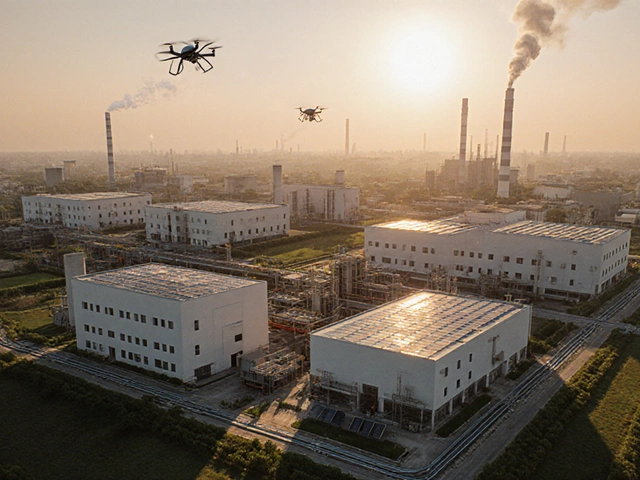Cipla vs Dr. Reddy's: The Ultimate Showdown in Pharma Manufacturing

Alright, let's get straight to the point. You're probably scratching your head over which company, Cipla or Dr. Reddy's, holds the crown in India's pharma arena. Hey, I get it. With so many medications out there, it's like trying to pick the best dish at a buffet where everything looks tempting.
But here's the deal. Before you make any decisions, understanding the history and prowess of these companies is crucial. Cipla, founded way back in 1935, has a reputation for affordability and quality. On the other side, Dr. Reddy's, which came into existence in 1984, is known for its global approach and innovation. Sounds like a showdown between the classic and the modern, right? Well, there's more beneath the surface.
- Company Backgrounds
- Product Range and Quality
- Market Presence and Impact
- Innovation and Future Prospects
Company Backgrounds
Diving into the history of Cipla and Dr. Reddy's gives us a solid foundation for understanding their prowess in the pharma industry. Cipla is like that seasoned player on the field, having started its journey in 1935. That was a time when India's pharmaceutical industry was still finding its feet. Founded by Dr. Khwaja Abdul Hamied, Cipla's mission was to make medicines accessible to everyone—a dream that's mirrored in its affordable products today.
Fast forward to 1984, and Dr. Reddy’s Laboratories came bursting onto the scene, courtesy of visionary Dr. Kallam Anji Reddy. While they were the new kids on the block back then, they quickly set about changing the game. Unlike Cipla, Dr. Reddy's aimed from the beginning to make waves globally. They channeled their efforts into research and development and have since become known for innovation and playing a big role in pushing generic medicines worldwide.
Both these giants started with clear goals, but their paths were slightly different. Cipla focused on mass production of affordable medicines, ensuring they reached every corner. Meanwhile, Dr. Reddy's took a more strategic approach, setting its sights on the future with generic drug development and international markets.
Talking numbers, Cipla today has over 1,500 products across various therapeutic categories, and that's no small feat. Dr. Reddy's isn't behind, either, having made significant strides in biosimilars and proprietary products.
Cipla and Dr. Reddy's each bring unique strengths to the table—Cipla in its commitment to accessibility and Dr. Reddy's in its innovative global reach. This mix shapes India's pharmaceutical landscape, making them industry heavyweights and setting the stage for their ongoing rivalry.
Product Range and Quality
When it comes to the range of products, both Cipla and Dr. Reddy's have quite the lineup, but they do serve different niches to a certain extent.
Cipla shines in the generics space, offering everything from antibiotics and anti-retrovirals to respiratory treatments. Their inhalers are pretty much legendary in the market for being reliable and affordable. Cipla's commitment to respiratory health is seen in their extensive portfolio of asthma and COPD medications, catering especially to those who might find cutting-edge treatments a bit pricey.
Meanwhile, Dr. Reddy's doesn't shy away from competition. They're big players in the over-the-counter segment and are pushing boundaries with biosimilars, which are essentially more affordable versions of biologic medicines. This is significant because biologics can be notoriously expensive. Dr. Reddy's global reach means their product standards are held to top-notch international benchmarks, making them a solid choice if you're looking for a mix of quality and affordability.
Both companies are neck and neck when it comes to cardiovascular and diabetes medications, but Dr. Reddy's often has an edge with its focus on research-driven innovations. Cipla focuses more on scaling production and ensuring their medicines reach more people. It really boils down to whether you're after innovation or accessibility.
Looking under the hood, the quality of their products also speaks volumes. Cipla’s manufacturing facilities are mostly accredited by international bodies like WHO-GMP, ensuring you get what's promised on the package—no surprise there! On the flip side, Dr. Reddy's prides itself on a holistic quality assurance process, involving rigorous checks right from R&D to production, cementing trust among users worldwide.

Market Presence and Impact
When it comes to their footprint in the pharmaceutical world, both Cipla and Dr. Reddy's have made quite the splash, but in different ways. Let's break it down.
Cipla has thrived by focusing heavily on the Indian market, where affordable meds are in high demand. They've also branched out effectively into African and Southeast Asian markets. Interesting tidbit: Cipla was among the first to offer affordable AIDS treatments, making a real difference in Africa.
Meanwhile, Dr. Reddy's has cast a wider net globally. They've got a strong presence in the U.S and Russia, and they're making inroads in European markets too. Their strategy has been about being flexible and innovative, allowing them to adapt quickly to changing regulations and needs in different regions.
| Company | Countries of Operation | Major Markets |
|---|---|---|
| Cipla | Over 80 | India, Africa, Southeast Asia |
| Dr. Reddy's | Over 50 | USA, Russia, Europe |
Now, if you're thinking numbers, both companies are giants with revenues that dance in the multi-billion dollar range. Still, Dr. Reddy's takes a slight edge in terms of global sales, thanks to its robust U.S. operations. But don't count Cipla out—it's the king in India's enormous generics sector, turning local needs into substantial profits.
So if your interest lies in global market reach, Dr. Reddy's might have a broader palette. But if local market dominance and impactful community initiatives tick your boxes, Cipla stands strong. Want to play it safe? Watch how both these contenders continue to adapt and grow in our ever-changing global landscape.
Innovation and Future Prospects
Alright, let’s unravel the future paths these two pharmaceutical giants are taking. Both Cipla and Dr. Reddy's are hustling hard in the innovation game, and it's not just about making pills anymore. It's more about who’s got the coolest ideas and who executes them best.
Cipla is leaning heavily into biopharmaceuticals, which are meds made using living cells. Sounds futuristic, right? They’re really pushing the envelope in biologics, wanting to offer solutions that go beyond just managing symptoms. They're also dipping their toes in digital healthcare, trying to bring healthcare to our smartphones. Think health monitoring apps and smart diagnostics.
Dr. Reddy's, on the flip side, is hitting the accelerator on biosimilars, which are kind of like generic versions of biologics. They're super focused on cutting down costs while keeping quality sky-high, which is a big deal in keeping meds accessible. They are also venturing into new forms of drug delivery—making ways to take medicine more efficient and, let's be honest, more convenient.
Looking ahead, both companies have their eyes set on expanding in global markets. They’re not just catering to India anymore. Cipla is focusing on Africa and Europe, while Dr. Reddy's is aiming to grow its presence in the US market. This means more competition and more innovation as they try to outdo each other.
Both companies are also on a mission to be more sustainable. They are investing in green technologies to reduce their carbon footprints. This might not sound as exciting as a new blockbuster drug, but it's crucial for long-term growth.
Here's a quick overview:
| Company | Innovation Focus | Future Market Expansion |
|---|---|---|
| Cipla | Biopharmaceuticals and Digital Healthcare | Africa and Europe |
| Dr. Reddy's | Biosimilars and Drug Delivery Systems | United States |
In short, they are both carving exciting paths for themselves. Whether you lean towards Cipla’s tech-savvy advancements or Dr. Reddy's knack for innovation in affordability, both are set to keep making waves in the pharma world.





